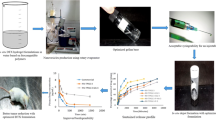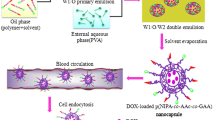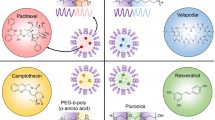Abstract
The objective of this work was to develop self-forming doxorubicin-loaded polymeric depots as an injectable drug delivery system for liver cancer chemotherapy and studied the release profiles of doxorubicin (Dox) from different depot formulations. Tri-block copolymers of poly(ε-caprolactone), poly(D,L-lactide) and poly(ethylene glycol) named PLECs were successfully used as a biodegradable material to encapsulate Dox as the injectable local drug delivery system. Depot formation and encapsulation efficiency of these depots were evaluated. Results show that depots could be formed and encapsulate Dox with high drug loading content. For the release study, drug loading content (10, 15 and 20% w/w) and polymer concentration (25, 30, and 35% w/v) were varied. It could be observed that the burst release occurred within 1–2 days and this burst release could be reduced by physical mixing of hydroxypropyl-beta-cyclodextrin (HP-β-CD) into the depot system. The degradation at the surface and cross-section of the depots were examined by Scanning Electron Microscope (SEM). In addition, cytotoxicity of Dox-loaded depots and blank depots were tested against human liver cancer cell lines (HepG2). Dox released from depots significantly exhibited potent cytotoxic effect against HepG2 cell line compared to that of blank depots. Results from this study reveals an important insight in the development of injectable drug delivery system for liver cancer chemotherapy.
Graphical Abstract
Schematic diagram of self-forming doxorubicin-loaded polymeric depots as an injectable drug delivery system and in vitro characterizations. (a) Dox-loaded PLEC depots could be formed with more than 90% of sustained-release Dox at 25% polymer concentration and 20% Dox-loading content. The burst release occurred within 1–2 days and could be reduced by physical mixing of hydroxypropyl-beta-cyclodextrin (HP-β-CD) into the depot system. (b) Dox released from depots significantly exhibited potent cytotoxic effect against human liver cancer cell lines (HepG2 cell line) compared to that of blank depots. (c) Dox-loaded depots showed bulk erosion with hollow core at day 60.






Similar content being viewed by others
References
Zender L, Spector MS, Xue W, Flemming P, Cordon-Cardo C, Silke J, et al. Identification and validation of oncogenes in liver cancer using an integrative oncogenomic approach. Cell. 2006;125(7):1253–67. doi:10.1016/j.cell.2006.05.030
Klintmalm GB. Liver transplantation for hepatocellular carcinoma: a registry report of the impact of tumor characteristics on outcome. Ann Surg. 1998;228(4):479–90.
Cheng WW, Allen TM. Targeted delivery of anti-CD19 liposomal doxorubicin in B-cell lymphoma: a comparison of whole monoclonal antibody, Fab’ fragments and single chain Fv. J Control Release. 2008;126(1):50–8. doi:10.1016/j.jconrel.2007.11.005
Thomas MB, O’Beirne JP, Furuse J, Chan AT, Abou-Alfa G, Johnson P. Systemic therapy for hepatocellular carcinoma: cytotoxic chemotherapy, targeted therapy and immunotherapy. Ann Surg Oncol. 2008;15(4):1008–14.
Tacar O, Sriamornsak P, Dass CR. Doxorubicin: an update on anticancer molecular action, toxicity and novel drug delivery systems. J Pharm Pharmacol. 2013;65(2):157–70. doi:10.1111/j.2042-7158.2012.01567.x
Jain RK. Delivery of molecular and cellular medicine to solid tumors. J Control Release. 1998;53(1–3):49–67. doi:10.1016/S0168-3659(97)00237-X
Jain RK. Vascular and interstitial barriers to delivery of therapeutic agents in tumors. Cancer Metastasis Rev. 1990;9(3):253–66.
Goh YM, Kong HL, Wang CH. Simulation of the delivery of doxorubicin to hepatoma. Pharm Res. 2001;18(6):761–70.
Theerasilp M, Nasongkla N. Comparative studies of poly(ε-caprolactone) and poly(D,L-lactide) as core materials of polymeric micelles. J Microencapsul. 2013;30(4):390–7. doi:10.3109/02652048.2012.746746
Sutton D, Nasongkla N, Blanco E, Gao JM. Functionalized micellar systems for cancer targeted drug delivery. Pharm Res-Dordr. 2007;24(6):1029–46. doi:10.1007/s11095-006-9223-y
Nasongkla N, Bey E, Ren J, Ai H, Khemtong C, Guthi JS, et al. Multifunctional polymeric micelles as cancer-targeted, MRI-ultrasensitive drug delivery systems. Nano Lett. 2006;6(11):2427–30. doi:10.1021/nl061412u
Shuai X, Ai H, Nasongkla N, Kim S, Gao J. Micellar carriers based on block copolymers of poly(ε-caprolactone) and poly(ethylene glycol) for doxorubicin delivery. J Control Release. 2004;98(3):415–26. doi:10.1016/j.jconrel.2004.06.003
Ma G, Zhang C, Zhang L, Sun H, Song C, Wang C, et al. Doxorubicin-loaded micelles based on multiarm star-shaped PLGA-PEG block copolymers: influence of arm numbers on drug delivery. J Mater Sci Mater Med. 2016;27(1):17 doi:10.1007/s10856-015-5610-4
Barenholz Y. Doxil® — The first FDA-approved nano-drug: lessons learned. J Control Release. 2012;160(2):117–34. doi:10.1016/j.jconrel.2012.03.020
Rouhollah K, Pelin M, Serap Y, Gozde U, Ufuk G. Doxorubicin loading, release, and stability of polyamidoamine dendrimer-coated magnetic nanoparticles. J Pharm Sci. 2013;102(6):1825–35. doi:10.1002/jps.23524
Shi Z, Guo R, Li W, Zhang Y, Xue W, Tang Y, et al. Nanoparticles of deoxycholic acid, polyethylene glycol and folic acid-modified chitosan for targeted delivery of doxorubicin. J Mater Sci Mater Med. 2014;25(3):723–31. doi:10.1007/s10856-013-5113-0
Yang Y, Jiang JS, Du B, Gan ZF, Qian M, Zhang P. Preparation and properties of a novel drug delivery system with both magnetic and biomolecular targeting. J Mater Sci-Mater Med.. 2009;20(1):301–7. doi:10.1007/s10856-008-3577-0
Weinberg BD, Ai H, Blanco E, Anderson JM, Gao J. Antitumor efficacy and local distribution of doxorubicin via intratumoral delivery from polymer millirods. J Biomed Mater Res A. 2007;81A(1):161–70. doi:10.1002/jbm.a.30914
Chanlen T, Hongeng S, Nasongkla N. Tri-component copolymer rods as an implantable reservoir drug delivery system for constant and controllable drug release rate. J Polym Res. 2012;19(12):1–12. doi:10.1007/s10965-012-0036-x
Manaspon C, Hongeng S, Boongird A, Nasongkla N. Preparation and in vitro characterization of SN-38-loaded, self-forming polymeric depots as an injectable drug delivery system. J Pharm Sci. 2012;101(10):3708–17. doi:10.1002/jps.23238
Khamlao W, Hongeng S, Sakdapipanich J, Nasongkla N. Preparation of self-solidifying polymeric depots from PLEC-PEG-PLEC triblock copolymers as an injectable drug delivery system. J Polym Res. 2012;19(3):1–12. doi:10.1007/s10965-012-9834-4
Manaspon C, Nittayacharn P, Vejjasilpa K, Fongsuk C, Nasongkla N SN-38:beta-cyclodextrin inclusion complex for in situ solidifying injectable polymer implants. Conference proceedings: Annual International Conference of the IEEE Engineering in Medicine and Biology Society IEEE Engineering in Medicine and Biology Society Annual Conference. 2011;2011:3241-4. 10.1109/IEMBS.2011.6090881.
Eliaz RE, Kost J. Characterization of a polymeric PLGA-injectable implant delivery system for the controlled release of proteins. J Biomed Mater Res. 2000;50(3):388–96. doi:10.1002/(SICI)1097-4636(20000605)50:3<388::AID-JBM13>3.0.CO;2-F
Zhao S-P, Xu W-L. Thermo-sensitive hydrogels formed from the photocrosslinkable polypseudorotaxanes consisting of β-cyclodextrin and Pluronic F68/PCL macromer. J Polym Res. 2010;17(4):503–10. doi:10.1007/s10965-009-9337-0
Weinberg B, Patel R, Wu H, Blanco E, Barnett C, Exner A, et al. Model simulation and experimental validation of intratumoral chemotherapy using multiple polymer implants. Med Biol Eng Comput. 2008;46(10):1039–49. doi:10.1007/s11517-008-0354-7
Nasongkla N, Boongird A, Hongeng S, Manaspon C, Larbcharoensub N. Preparation and biocompatibility study of in situ forming polymer implants in rat brains. J Mater Sci: Mater Med. 2012;23(2):497–505. doi:10.1007/s10856-011-4520-3
Boongird A, Nasongkla N, Hongeng S, Sukdawong N, Sa-Nguanruang W, Larbcharoensub N. Biocompatibility study of glycofurol in rat brains. Exp Biol Med. 2011;236(1):77–83. doi:10.1258/ebm.2010.010219
Vejjasilpa K, Nasongkla N, Manaspon C, Larbcharoensub N, Boongird A, Hongeng S, et al. Antitumor efficacy and intratumoral distribution of SN-38 from polymeric depots in brain tumor model. Exp Biol Med. 2015;240(12):1640–7. doi:10.1177/1535370215590819
Nittayacharn P, Manaspon C, Hongeng S, Nasongkla N. HPLC analysis and extraction method of SN-38 in brain tumor model after injected by polymeric drug delivery system. Exp Biol Med. 2014;239(12):1619–29. doi:10.1177/1535370214539227
Zhang Y, Wang CC, Yang WL, Shi B, Fu SK. Tri-component diblock copolymers of poly(ethylene glycol)-poly(epsilon-caprolactone-co-lactide): synthesis, characterization and loading camptothecin. Colloid Polym Sci. 2005;283(11):1246–52. doi:10.1007/s00396-005-1306-5
Astaneh R, Moghimi HM, Erfan M, Mobedi H. Formulation of an injectable implant for peptide delivery. J Pept Sci. 2006;12:241
Nasongkla N, Boongird A, Hongeng S, Manaspon C, Larbcharoensub N. Preparation and biocompatibility study of in situ forming polymer implants in rat brains. J Mater Sci-Mater Med. 2012;23(2):497–505. doi:10.1007/s10856-011-4520-3
Hu Y, Jiang XQ, Ding Y, Zhang LY, Yang CZ, Zhang JF, et al. Preparation and drug release behaviors of nimodipine-loaded poly(caprolactone)-poly(ethylene oxide)-polylactide amphiphilic copolymer nanoparticles. Biomaterials. 2003;24(13):2395–404. doi:10.1016/S0142-9612(03)00021-8
Chen DR, Chen HL, Bei JZ, Wang SG. Morphology and biodegradation of microspheres of polyester-polyether block copolymer based on polycaprolactone/polylactide/poly(ethylene oxide). Polym Int. 2000;49(3):269–76. doi: 10.1002/(Sici)1097-0126(200003)49:3<269::Aid-Pi358>3.0.Co;2-Z
Nasongkla N, Nittayacharn P, Rotjanasitthikit A, Pungbangkadee K, Manaspon C. Paclitaxel-loaded polymeric depots as injectable drug delivery system for cancer chemotherapy of hepatocellular carcinoma. Pharm Dev Technol. 2016;0(0):1–7. doi:10.3109/10837450.2016.1163389
Wang PP, Frazier J, Brem H. Local drug delivery to the brain. Adv Drug Deliv Rev. 2002;54(7):987–1013.
Ahmed F, Discher DE. Self-porating polymersomes of PEG-PLA and PEG-PCL: hydrolysis-triggered controlled release vesicles. J Control Release. 2004;96(1):37–53. doi:10.1016/j.jconrel.2003.12.021
Woodruff MA, Hutmacher DW. The return of a forgotten polymer—Polycaprolactone in the 21st century. Progress Polym Sci. 2010;35(10):1217–56. doi:10.1016/j.progpolymsci.2010.04.002
Omelczuk MO, McGinity JW. The influence of polymer glass transition temperature and molecular weight on drug release from tablets containing poly(DL-lactic Acid). Pharm Res 9(1):26–32. 10.1023/a:1018967424392.
Li S, Molina I, Martinez MB, Vert M. Hydrolytic and enzymatic degradations of physically crosslinked hydrogels prepared from PLA/PEO/PLA triblock copolymers. J Mater Sci: Mater Med 13(1):81–6. 10.1023/a:1013651022431.
Garlotta D. A literature review of poly(lactic acid). J Polym Environ. 2001;9(2):63–84. doi:Unsp 1566-2543/01/0400-0063/0Doi 10.1023/A:1020200822435
Manaspon C, Nasongkla N, Chaimongkolnukul K, Nittayacharn P, Vejjasilpa K, Kengkoom K, et al. Injectable SN-38-loaded polymeric depots for cancer chemotherapy of glioblastoma multiforme. Pharm Res. 2016;33(12):2891–903. doi:10.1007/s11095-016-2011-4
Missirlis D, Kawamura R, Tirelli N, Hubbell JA. Doxorubicin encapsulation and diffusional release from stable, polymeric, hydrogel nanoparticles. Eur J Pharm Sci. 2006;29(2):120–9. doi:10.1016/j.ejps.2006.06.003
Alakhov V, Klinski E, Li S, Pietrzynski G, Venne A, Batrakova E, et al. Block copolymer-based formulation of doxorubicin. From cell screen to clinical trials. Colloids Surf B: Biointerfaces. 1999;16(1–4):113–34. doi:10.1016/S0927-7765(99)00064-8
Xiao K, Luo J, Li Y, Lee JS, Fung G, Lam KS. PEG-oligocholic acid telodendrimer micelles for the targeted delivery of doxorubicin to B-cell lymphoma. J Control Release. 2011;155(2):272–81. doi:10.1016/j.jconrel.2011.07.018
Oh KT, Lee ES, Kim D, Bae YH. l-Histidine-based pH-sensitive anticancer drug carrier micelle: reconstitution and brief evaluation of its systemic toxicity. Int J Pharm. 2008;358(1–2):177–83. doi:10.1016/j.ijpharm.2008.03.003
Lv SX, Li MQ, Tang ZH, Song WT, Sun H, Liu HY, et al. Doxorubicin-loaded amphiphilic polypeptide-based nanoparticles as an efficient drug delivery system for cancer therapy. Acta Biomater. 2013;9(12):9330–42. doi:10.1016/j.actbio.2013.08.015
Lee CC, Gillies ER, Fox ME, Guillaudeu SJ, Frechet JMJ, Dy EE, et al. A single dose of doxorubicin-functionalized bow-tie dendrimer cures mice bearing C-26 colon carcinomas. P Natl Acad Sci USA. 2006;103(45):16649–54. doi:10.1073/pnas.0607705103
Yoo HS, Lee KH, Oh JE, Park TG. In vitro and in vivo anti-tumor activities of nanoparticles based on doxorubicin–PLGA conjugates. J Control Release. 2000;68(3):419–31. doi:10.1016/S0168-3659(00)00280-7
Janes KA, Fresneau MP, Marazuela A, Fabra A. Alonso MaJ. Chitosan nanoparticles as delivery systems for doxorubicin. J Control Release. 2001;73(2–3):255–67. doi:10.1016/S0168-3659(01)00294-2
Qian F, Stowe N, Saidel GM, Gao J. Comparison of doxorubicin concentration profiles in radiofrequency-ablated rat livers from sustained- and dual-release PLGA millirods. Pharm Res 21(3):394–9. 10.1023/b:pham.0000019290.70358.30.
Rosenberg R, Devenney W, Siegel S, Dan N. Anomalous release of hydrophilic drugs from poly(ϵ-caprolactone) matrices. Mol Pharm. 2007;4(6):943–8. doi:10.1021/mp700097x
Qian F, Nasongkla N, Gao J. Membrane-encased polymer millirods for sustained release of 5-fluorouracil. J Biomed Mater Res. 2002;61(2):203–11. doi:10.1002/jbm.10156
Merisko-Liversidge E, Liversidge GG, Cooper ER. Nanosizing: a formulation approach for poorly-water-soluble compounds. Eur J Pharm Sci. 2003;18(2):113–20. doi:10.1016/S0928-0987(02)00251-8
Davis ME, Brewster ME. Cyclodextrin-based pharmaceutics: past, present and future. Nat Rev Drug Discov. 2004;3(12):1023–35. doi:10.1038/nrd1576
Karande P, Mitragotri S. Enhancement of transdermal drug delivery via synergistic action of chemicals. Bba-Biomembranes.. 2009;1788(11):2362–73. doi:10.1016/j.bbamem.2009.08.015
Garcia-Rodriguez JJ, Torrado J, Bolas F. Improving bioavailability and anthelmintic activity of albendazole by preparing albendazole-cyclodextrin complexes. Parasite. 2001;8(2):S188–S90.
Donnelly JP, De Pauw BE. Voriconazole - a new therapeutic agent with an extended spectrum of antifungal activity. Clin Microbiol Infec. 2004;10:107–17. doi:10.1111/j.1470-9465.2004.00838.x
Bekers O, Kettenesvandenbosch JJ, Vanhelden SP, Seijkens D, Beijnen JH, Bult A, et al. Inclusion complex-formation of anthracycline antibiotics with cyclodextrins - a proton nuclear-magnetic-resonance and molecular modeling study. J Inclus Phenom Mol. 1991;11(2):185–93. doi:10.1007/Bf01153301
Bekers O, Beijnen JH, Otagiri M, Bult A, Underberg WJ. Inclusion complexation of doxorubicin and daunorubicin with cyclodextrins. J Pharm Biomed Anal. 1990;8(8–12):671–4.
Hu Y, Ding Y, Li Y, Jiang X, Yang C, Yang Y. Physical stability and lyophilization of poly(epsilon-caprolactone)-b-poly(ethyleneglycol)-b-poly(epsilon-caprolactone) micelles. J Nanosci Nanotechnol. 2006;6(9-10):3032–9.
De Souza R, Zahedi P, Allen CJ, Piquette-Miller M. Biocompatibility of injectable chitosan–phospholipid implant systems. Biomaterials. 2009;30(23–24):3818–24. doi:10.1016/j.biomaterials.2009.04.003
Grever MR, Schepartz SA, Chabner BA. The National Cancer Institute: cancer drug discovery and development program. Semin Oncol. 1992;19(6):622–38.
Alley MC, Scudiero DA, Monks A, Hursey ML, Czerwinski MJ, Fine DL, et al. Feasibility of drug screening with panels of human tumor cell lines using a microculture tetrazolium assay. Cancer Res. 1988;48(3):589–601.
Acknowledgements
This research project was supported by Thailand Research Fund, Thailand.
Author information
Authors and Affiliations
Corresponding author
Ethics declarations
Conflict of interest
The authors declare that they have no competing interests.
Electronic supplementary material
Rights and permissions
About this article
Cite this article
Nittayacharn, P., Nasongkla, N. Development of self-forming doxorubicin-loaded polymeric depots as an injectable drug delivery system for liver cancer chemotherapy. J Mater Sci: Mater Med 28, 101 (2017). https://doi.org/10.1007/s10856-017-5905-8
Received:
Accepted:
Published:
DOI: https://doi.org/10.1007/s10856-017-5905-8




